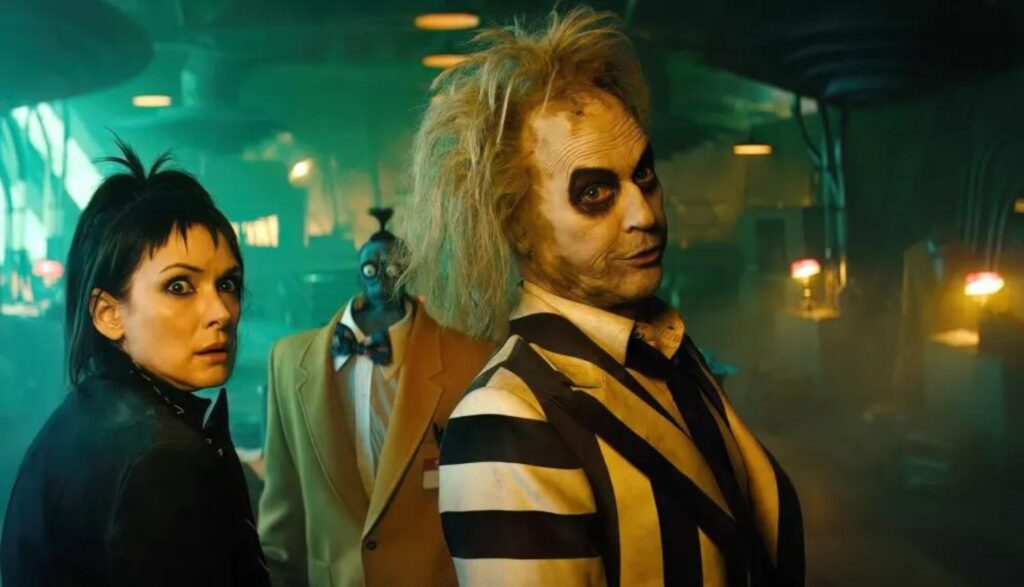
Don’t say it. Just don’t.
Lydia Deetz knows all about what happens when you say that name three times. She knows just what havoc that ghost/demon/thing can unleash if you unleash him. Why, in 1988, then 16-year-old Lydia was almost forced to marry the guy.
Fast-forward a few decades, and Lydia’s moved on. No, not moved on, as in an eternal sense. Rather, she’s put her goth, morbid teen years behind her. She’s now a goth, morbid adult—and she’s making a pretty good living at it, too. She spelunks through so-called haunted houses, then unpacks her adventures on TV.
And if she occasionally sees a familiar sheet-white face staring at her from a familiar black-and-white-striped shirt … well, surely that’s her imagination, right? Surely.
But then, a family tragedy forces Lydia—indeed, the whole Deetz family—back to their country home in Winter River, Connecticut, where Beetlejuice (oops) first popped into their lives.
Lydia’s father, Charles, recently died in a plane crash/shark attack. It’s time to lay the man’s memory to rest in Winter Grove. Widow Delia drapes the family house in black fabric and holds what she calls a “grief collective.” Lydia pulls her own sulky daughter—Astrid—out of school. And Rory, Lydia’s TV-producer-turned-boyfriend, is coming along as well.
The whole trip will make for a nice moment of closure. A time for the family to be together. A time, perhaps, for Lydia to patch up her relationship with Astrid.
But events never go as planned in Winter Grove. Rory proposes to Lydia during Charles’ wake. And Lydia—feeling Rory’s desperation and the gaze of dozens of curious grievers—says yes. Astrid, horrified that her mom is marrying that guy, soon bikes away to clear her head. She runs her bike straight into a tree. And out of the treehouse perched in said tree, a guy about her age pops his head out and introduces himself as Jeremy.
And suddenly, Astrid’s stay in Winter Grove is beginning to look up.
Meanwhile, Beetlejuice (oops) is dealing with his own issues down below. His literal soul-sucking ex-wife, Delores, is trying to track him down in the afterlife. Should she find him, Delores intends for him a fate literally worse than death. (Since both are already dead, that wouldn’t be hard.) But the demon would very much like to renew his acquaintance with Lydia—to finally get hitched, just like they (well, he) planned all those years ago.
All he needs to get the ball rolling is for someone to say his name three times: Beetlejuice.
(Oops.)
Without giving too much away, Astrid makes a serious mistake—a mistake so serious that it lands her in the afterlife’s netherworld, and nearly forces her aboard the one-way Soul Train to destinations unknown. But Lydia risks life and death and some other serious consequences to save her little girl. And that, as you might imagine, does wonders for their relationship.
Astrid believes her mother’s a huckster. A fraud. “I believe in things that I can see,” she tells Jeremy. “Science. Facts.”
But if Astrid initially believes that the immortal soul and life after death is just so much hokum, Beetlejuice Beetlejuice takes pains to prove otherwise.
We arguably spend more time with the dead than with the living here, and the afterlife they inhabit is a strange place indeed. Beetlejuice Beetlejuice suggests that the grimy, twisted necropolis we see is more or less a holding area: The dead eventually board the Soul Train to the “Great Beyond, featuring locales such as the Elysian Fields and the Fires of Damnation. (We see one person fall to his fiery doom.) Naturally (or unnaturally), we see scads of dead people wander about, too.
The afterlife has a great many rules to follow, too—all outlined in the Handbook for the Recently Deceased. As such, characters utter strange incantations, sign contracts in blood, stamp forms and break bylaws.
Lydia describes Beetlejuice as a “trickster demon,” and there’s certainly something diabolical about the guy. When he crosses himself, for instance, Beetlejuice sets himself on fire.
But we also learn that he and Delores were once regular ol’ people, albeit people who got hitched by way of a dark ceremony that involved drinking each other’s blood, biting the heads off chickens and sacrificing a goat.
Topside, superficial Christianity still seems to hold some sway in Winter Grove. We repeatedly see the village church and meet its priest (who speaks generally and confusingly about heaven and hell). And the extended climactic scene takes place in a sanctuary decorated by a huge cross. Delia wears a cross around her neck during her late husband’s wake, too—though her own spiritual leanings seem to be more of a make-your-own-New-Age-faith type thing.
The same could be said for both Lydia and Rory as well, who met at some sort of a hip, metaphysical grief retreat. Astrid profanely refers to Rory’s vibe as “New Age bull—.” Delia performs a makeshift grief ceremony at Charles’ gravesite. Instead of hymns, children sing the “Banana Boat” song at Charles’ memorial service. A wedding seems to take place in a church. We read a reference to a Ouija board.
In a flashback, Beetlejuice and Delores engage in passionate lovemaking. (We see clothes comically fly into the air and a few humorously suggestive movements in shadows, but nothing critical is seen.)
In the “present,” Delores’ dismembered body reassembles itself. In the process of becoming fully whole, we see quite a bit of her cleavage and thighs as she staples herself back together.
Beetlejuice occasionally leers at women, and Astrid finds one of his old flyers that market him as a love/sex doctor. (“Ewww,” Astrid says.) Delia’s latest avant-garde art project involves turning her own body into a canvas: We don’t see anything critical, but a shapely (but ill-defined) nude mannequin graces one of her exhibit cubes.
Various characters kiss one another. Astrid spends some unsupervised time in Jeremy’s room (though nothing outside a kiss takes place there). Delia mourns Charles, whom she calls her “horny handyman.”
Beetlejuice’s past “romance” with Lydia (as documented in the original 1988 film) forms a central nexus in which this story revolves, of course. And while Beetlejuice Beetlejuice doesn’t dwell on the age difference, we should remind you that Lydia was just 16 years old at the time.
Beetlejuice Beetlejuice delights in its running gags. And the biggest and most gag-worthy is its parade of walking corpses, all of which display their grotesquely humorous modes of demise. It’d be impossible to catalog them all here, but here are some notable examples:
Charles, as we mentioned, died in a plane crash/shark attack. We see a Claymation reenactment of the tragic event, complete with a burst of blood covering the camera at the end. He’s an ancillary character here, too, walking around the afterlife sans head and torso. We see his bloody guts contained in the rest of the guy’s body, like Cheerios in a cereal bowl, and when he talks (and yes, he does talk), blood spurts from an extended artery and onto walls, floors and people. Another notable character walks around with part of his brain and facial muscles exposed (though the guts here are far more cartoonish). And as mentioned, Delores stapled most of herself back together with a staple gun.
Several dead people hang out in the afterlife’s interminable waiting room, including a surfer (or rather, the upper body of a surfer), a seriously charred Santa Claus (whom, we assume, met his demise in a chimney) and a competitive eater (whose mouth is stuffed with hot dogs). Perhaps the most horrible waitee, though, might be a cat lady who’s been snacked on by her favorite felines. (A full leg bone is exposed, and the tabbies are still chewing on other parts of her as well.) Someone walks around with a javelin or harpoon sticking through her neck. Several characters have shrunken heads with stitched-together mouths. Piranhas chew on a guy in perpetuity. Someone apparently died from an eggbeater to the eye. A power saw adorns the face of another.
There are fates worse than death, though. Delores literally sucks whatever life is left out of several folks and walks away, leaving them looking like deflated balloons. This, it seems, makes Delores’ victims really dead.
Also worth noting: A newborn version of Beetlejuice is birthed—a couple of times—quite messily. In one sequence, he gnaws the “mother’s” leg bloody. In another, he murders the attending doctor in a seemingly R-rated spray of blood.
Astrid nearly crashes into several cars before thudding into a tree. A giant sandworm attacks and, in one case, seems to devour a person or two. Surreal guts are literally spilled. Bat wings appear to flap out of Beetlejuice’s face. Someone drinks poison. We learn that one character is a murderer. Astrid reminisces about the “age-inappropriate” costumes (because they were too gory, not too sexually inappropriate) that her father designed for her for Halloween. Someone’s bitten by poisonous snakes. And so on.
We hear one f-word, one bleeped f-word and another incomplete f-word that melds into a different profanity. Also on tap: a dozen s-words and a smattering of other profanities, including “a–,” “crap,” “h—” and “p-ssed.” God’s name is misused seven times, three with the word “d–n,” and Jesus’ name is abused once.
It’s suggested that Lydia and Rory both take prescription pills for recreational use. When Rory sees that Lydia’s hiding a vial of such pills, he dumps them into a trash can—then digs them out so they can both partake. “This is the last time I dig pills out of a trash can for you, understand?” he scolds.
Characters drink wine. Jeremy confesses to sneaking six-packs of beer up to his treehouse behind his father’s back. The town’s priest, Father Damien, seems to have a barely concealed drinking problem.
Beetlejuice exudes rude-sounding noises at times, and he talks about needing to use the restroom. Astrid and Lydia have a difficult relationship—so much so that when Lydia calls Astrid, the name that pops up on her phone is “Alleged Mom.” Characters lie and mislead.
The entertainment industry has always been just that: an industry. While some films indeed aspire to be art, the business itself is predicated on costs, profits and the bottom line. Sure, most filmmakers want to make good movies. But the folks who sign the checks? They want successful movies.
And in the quest for the next big success, studios are dusting off successful-but-aged films—sometimes 20, 30 or 40 years old—and sequel-izing them.
But to borrow and twist a line from Jurassic Park (a film all about bringing old things back to life), Just because a sequel can be made, should it?
Beetlejuice Beetlejuice feels like pure fan service. Director Tim Burton is still the cinematic master of Edward Gorey-style gloom and guffaws. The titular antihero (whose name is actually spelled Betelgeuse) is as crass and wacky as ever. The supporting cast displays an entertaining level of dysfunction. Yes, there’s even a dance number akin to the famed “Banana Boat” number from the original Beetlejuice—featuring possessed performers, outsized dance moves and an earworm song in all their derivative glory.
For those who have a soft spot for the original Beetlejuice, the sequel will scratch that scabby itch.
But when you scratch a scab, there will be blood. Oh, yes.
If a drama contained the same level of blood and gore as Beetlejuice Beetlejuice, I suspect that it would’ve been rated R. But because the film embraces a macabre sense of humor, the censors give it a pass. And indeed, some of the ooky elements we see here do feel cartoonish. But others can feel pulled straight out of a bloody, wince-and-turn-away exorcism movie.
And while we’re on the subject of exorcisms, let’s not forget that Beetlejuice is—at least according to Lydia—a demon. And we laugh with and even root for that demon throughout much of the movie. (As a villain, he plays, at best, third fiddle here.) The film is predicated on calling on infernal players to do their mortal will—and at their own mortal peril. This is a Faustian story without much moral or a whiff of regard for real spirituality. That’s an issue worth thinking through.
I’m not immune to the dour charms of Tim Burton. But Beetlejuice Beetlejuice, like its namesake, can be deceptively problematic. And I’d think long and hard before calling it up.


Paul Asay has been part of the Plugged In staff since 2007, watching and reviewing roughly 15 quintillion movies and television shows. He’s written for a number of other publications, too, including Time, The Washington Post and Christianity Today. The author of several books, Paul loves to find spirituality in unexpected places, including popular entertainment, and he loves all things superhero. His vices include James Bond films, Mountain Dew and terrible B-grade movies. He’s married, has two children and a neurotic dog, runs marathons on occasion and hopes to someday own his own tuxedo. Feel free to follow him on Twitter @AsayPaul.